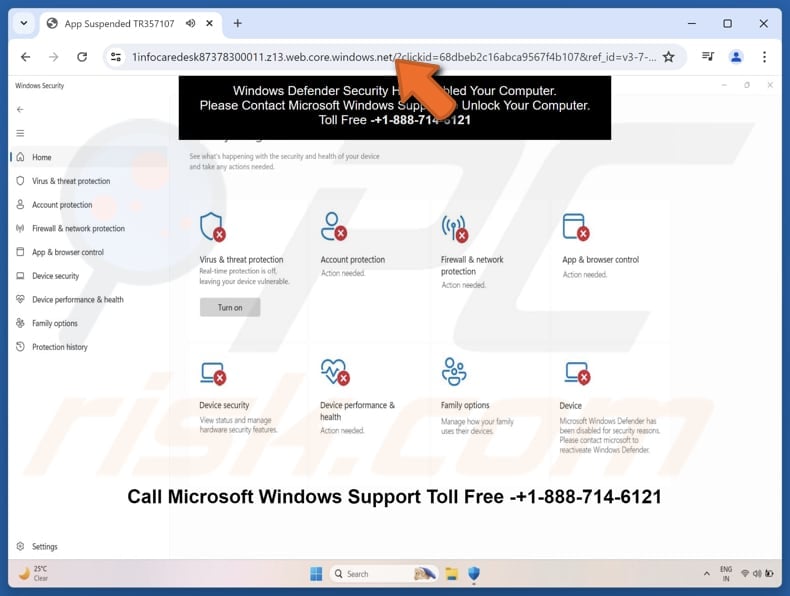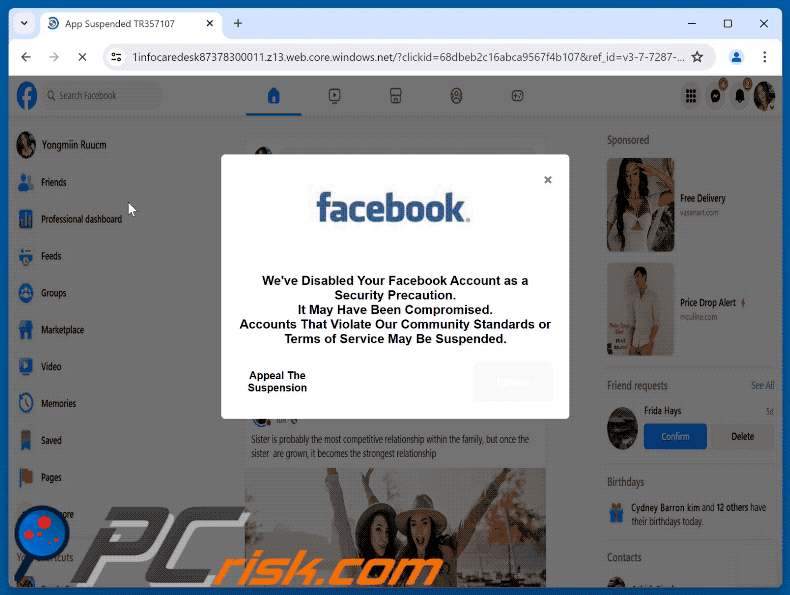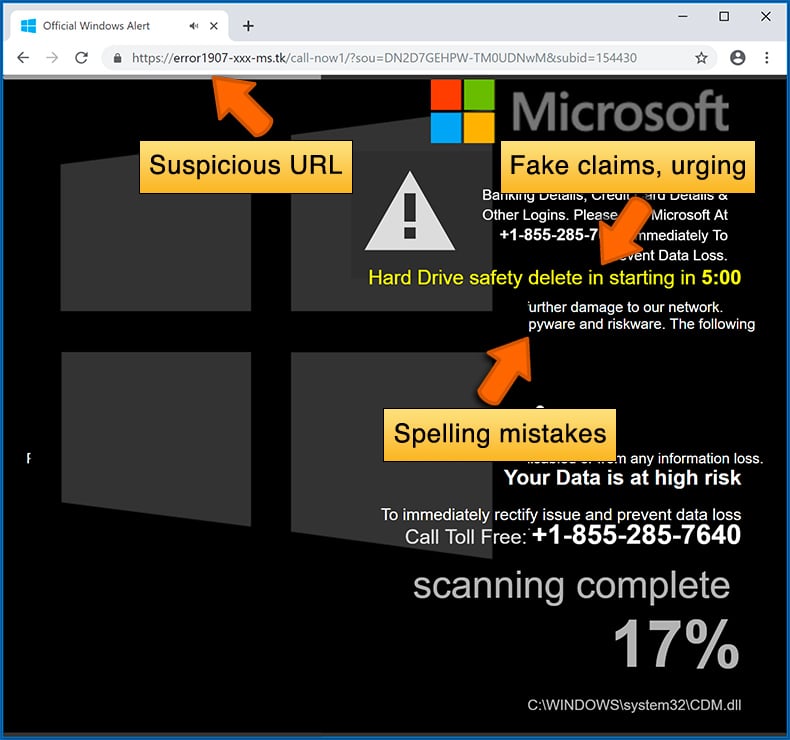How to spot scams like "Windows Defender Security Has Disabled Your Computer"
Phishing/ScamAlso Known As: Windows Defender Security Has Disabled Your Computer tech support scam
Get free scan and check if your device is infected.
Remove it nowTo use full-featured product, you have to purchase a license for Combo Cleaner. Seven days free trial available. Combo Cleaner is owned and operated by RCS LT, the parent company of PCRisk.com.
What kind of scam is "Windows Defender Security Has Disabled Your Computer"?
Our analysis shows that the site is a scam featuring a fake Windows Defender alert. It is crafted to trick visitors into believing that there is an issue with their computers and calling a number operated by fraudsters. This type of fraud is called a tech support scam and should be ignored and avoided if encountered.

"Windows Defender Security Has Disabled Your Computer" in detail
Initially, this scam site shows a fake Facebook alert claiming that the user's Facebook account has been disabled as a precaution due to a potential breach. More on this scam here: "We've Disabled Your Facebook Account POP-UP Scam". Also, this scam often uses the aforementioned message as its secondary lure and is associated with another scam ("Microsoft Has Temporarily Suspended Your Account").
The main message on this scam page poses as an alert from "Windows Defender Security". This fake warning claims that Windows Defender has disabled the user's computer and instructs them to call Microsoft Windows Support at the provided toll-free number (+1-888-714-6121) to unlock it.
The scam also involves a fake "Windows Security" window in the operating system's security settings. The main purpose of this tech support scam is to trick unsuspecting visitors into calling scammers.
If contacted, fraudsters usually try to steal sensitive information such as login credentials, personal identification information, or credit card details, install malicious software, or trick users into paying for fake services or products. If the scam involves delivering malware, attackers frequently use remote access tools to take control of the device.
Common examples of these scams include those using UltraViewer and TeamViewer.
| Name | Windows Defender Security Has Disabled Your Computer tech support scam |
| Threat Type | Phishing, Scam, Social Engineering, Fraud |
| Fake Claim | Computer has been disabled by Windows Defender |
| Disguise | Legitimate alert from Windows Defender |
| Tech Support Scammer Phone Number | +1-888-714-6121 |
| Related Domain | 1infocaredesk87378300011.z13.web.core.windows[.]net |
| Detection Names (1infocaredesk87378300011.z13.web.core.windows[.]net) | Yandex Safebrowsing (Phishing), Full List Of Detections (VirusTotal) |
| Symptoms | Fake error messages, fake system warnings, pop-up errors, hoax computer scan. |
| Distribution methods | Compromised websites, rogue online pop-up ads, potentially unwanted applications. |
| Damage | Loss of sensitive private information, monetary loss, identity theft, possible malware infections. |
| Malware Removal (Windows) |
To eliminate possible malware infections, scan your computer with legitimate antivirus software. Our security researchers recommend using Combo Cleaner. Download Combo CleanerTo use full-featured product, you have to purchase a license for Combo Cleaner. 7 days free trial available. Combo Cleaner is owned and operated by RCS LT, the parent company of PCRisk.com. |
Conclusion
This scam uses fake Facebook and Windows Defender alerts to trick users into calling a provided phone number. Falling for this scam can result in monetary loss, identity theft, account hijacking, computer infections, or other issues. Thus, it is important to recognize such scams and ignore them.
More examples of similar scams are "Microsoft Has Temporarily Suspended Your Account", "Error_Code: GUI45WGV0001", and "Microsoft Account Locked".
How did I open a scam website?
Fraudulent websites are frequently reached through ads, links, buttons, etc., on unreliable websites, notifications from untrustworthy sites, and through emails with deceptive links or attachments. Rogue advertising networks also promote scams, often appearing on torrent, adult, or illegal streaming platforms.
In some cases, unwanted browser extensions or ads displayed by adware can redirect users to these malicious sites. Overall, users are lured into opening scam websites in various ways.
How to avoid visiting scam pages?
Be cautious with emails or messages from unknown senders, especially if they are unexpected, irrelevant, or contain links or attachments. Avoid clicking on suspicious ads or links on suspicious websites, and never agree to receive notifications from such web pages.
Always use official websites or reputable stores for software downloads. Additionally, a device can be protected by using trusted antivirus software and regularly updating the operating system and applications. If your computer is already infected with unwanted apps, we recommend running a scan with Combo Cleaner Antivirus for Windows to automatically eliminate them.
The appearance of "Windows Defender Security Has Disabled Your Computer" pop-up scam (GIF):

Text in the fake Facebook alert:
We've Disabled Your Facebook Account as a Security Precaution.
It May Have Been Compromised.
Accounts That Violate Our Community Standards or Terms of Service May Be Suspended.Appeal The Suspension
Text in the fake Windows Defender alert:
Windows Defender Security Has Disabled Your Computer.
Please Contact Microsoft Windows Support To Unlock Your Computer.
Toll Free -+1-888-714-6121
Instant automatic malware removal:
Manual threat removal might be a lengthy and complicated process that requires advanced IT skills. Combo Cleaner is a professional automatic malware removal tool that is recommended to get rid of malware. Download it by clicking the button below:
DOWNLOAD Combo CleanerBy downloading any software listed on this website you agree to our Privacy Policy and Terms of Use. To use full-featured product, you have to purchase a license for Combo Cleaner. 7 days free trial available. Combo Cleaner is owned and operated by RCS LT, the parent company of PCRisk.com.
Quick menu:
- What is Windows Defender Security Has Disabled Your Computer tech support scam?
- How to identify a pop-up scam?
- How do pop-up scams work?
- How to remove fake pop-ups?
- How to prevent fake pop-ups?
- What to do if you fell for a pop-up scam?
How to identify a pop-up scam?
Pop-up windows with various fake messages are a common type of lures cybercriminals use. They collect sensitive personal data, trick Internet users into calling fake tech support numbers, subscribe to useless online services, invest in shady cryptocurrency schemes, etc.
While in the majority of cases these pop-ups don't infect users' devices with malware, they can cause direct monetary loss or could result in identity theft.
Cybercriminals strive to create their rogue pop-up windows to look trustworthy, however, scams typically have the following characteristics:
- Spelling mistakes and non-professional images - Closely inspect the information displayed in a pop-up. Spelling mistakes and unprofessional images could be a sign of a scam.
- Sense of urgency - Countdown timer with a couple of minutes on it, asking you to enter your personal information or subscribe to some online service.
- Statements that you won something - If you haven't participated in a lottery, online competition, etc., and you see a pop-up window stating that you won.
- Computer or mobile device scan - A pop-up window that scans your device and informs of detected issues - is undoubtedly a scam; webpages cannot perform such actions.
- Exclusivity - Pop-up windows stating that only you are given secret access to a financial scheme that can quickly make you rich.
Example of a pop-up scam:

How do pop-up scams work?
Cybercriminals and deceptive marketers usually use various advertising networks, search engine poisoning techniques, and shady websites to generate traffic to their pop-ups. Users land on their online lures after clicking on fake download buttons, using a torrent website, or simply clicking on an Internet search engine result.
Based on users' location and device information, they are presented with a scam pop-up. Lures presented in such pop-ups range from get-rich-quick schemes to fake virus scans.
How to remove fake pop-ups?
In most cases, pop-up scams do not infect users' devices with malware. If you encountered a scam pop-up, simply closing it should be enough. In some cases scam, pop-ups may be hard to close; in such cases - close your Internet browser and restart it.
In extremely rare cases, you might need to reset your Internet browser. For this, use our instructions explaining how to reset Internet browser settings.
How to prevent fake pop-ups?
To prevent seeing pop-up scams, you should visit only reputable websites. Torrent, Crack, free online movie streaming, YouTube video download, and other websites of similar reputation commonly redirect Internet users to pop-up scams.
To minimize the risk of encountering pop-up scams, you should keep your Internet browsers up-to-date and use reputable anti-malware application. For this purpose, we recommend Combo Cleaner Antivirus for Windows.
What to do if you fell for a pop-up scam?
This depends on the type of scam that you fell for. Most commonly, pop-up scams try to trick users into sending money, giving away personal information, or giving access to one's device.
- If you sent money to scammers: You should contact your financial institution and explain that you were scammed. If informed promptly, there's a chance to get your money back.
- If you gave away your personal information: You should change your passwords and enable two-factor authentication in all online services that you use. Visit Federal Trade Commission to report identity theft and get personalized recovery steps.
- If you let scammers connect to your device: You should scan your computer with reputable anti-malware (we recommend Combo Cleaner Antivirus for Windows) - cyber criminals could have planted trojans, keyloggers, and other malware, don't use your computer until removing possible threats.
- Help other Internet users: report Internet scams to Federal Trade Commission.
Frequently Asked Questions (FAQ)
What is a pop-up scam?
In a pop-up scam, false messages (e.g., warnings) appear on websites to scare or entice users, claiming issues like infections, account problems, or prize winnings.
What is the purpose of a pop-up scam?
The goal of these pop-ups is to get you to click, call, or download something, which can result in stolen information, malware, or financial loss.
Why do I encounter fake pop-ups?
Deceptive websites are often accessed through scam emails, misleading links, ads, or notifications. They may also be distributed via rogue advertising networks, which are commonly found on torrent, adult, or illegal streaming sites, and sometimes through unwanted browser extensions or other apps.
Will Combo Cleaner protect me from pop-up scams?
Combo Cleaner is designed to check every website you visit for malicious content. It can also spot sites that show pop-up scams, immediately warn you, and block access.
Share:

Tomas Meskauskas
Expert security researcher, professional malware analyst
I am passionate about computer security and technology. I have an experience of over 10 years working in various companies related to computer technical issue solving and Internet security. I have been working as an author and editor for pcrisk.com since 2010. Follow me on Twitter and LinkedIn to stay informed about the latest online security threats.
PCrisk security portal is brought by a company RCS LT.
Joined forces of security researchers help educate computer users about the latest online security threats. More information about the company RCS LT.
Our malware removal guides are free. However, if you want to support us you can send us a donation.
DonatePCrisk security portal is brought by a company RCS LT.
Joined forces of security researchers help educate computer users about the latest online security threats. More information about the company RCS LT.
Our malware removal guides are free. However, if you want to support us you can send us a donation.
Donate
▼ Show Discussion